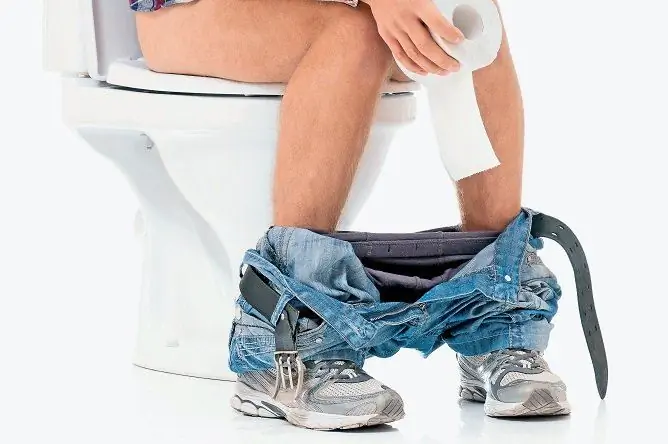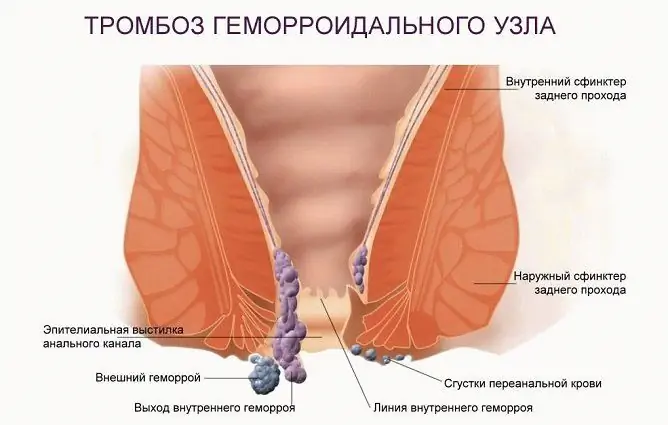- Author Rachel Wainwright [email protected].
- Public 2023-12-15 07:39.
- Last modified 2025-11-02 20:14.
The initial stage of hemorrhoids in women and men: symptoms, causes, treatment and prevention
The content of the article:
- Disease symptoms
- Causes and types of hemorrhoids
- Diagnostics and treatment
- Prevention of hemorrhoids
The initial stage of hemorrhoids occurs due to the progressive stagnation of blood in the hemorrhoidal veins and is characterized by noticeable swelling of the rectal wall, itching in the perianal region, aching visceral pain during bowel movements, and bleeding. With timely treatment, the disease at this stage is treated conservatively.
Disease symptoms
The initial stage of hemorrhoids is manifested by the following symptoms:
- burning, itching, painful sensations in the anus, arising from the pressure of the surrounding tissues on the thinned wall of the veins of the hemorrhoidal plexus;
- bleeding - occurs due to inflammation and rupture of small vessels of the mucous membrane. Blood from hemorrhoids is red in color, which helps to distinguish it from black stools in more serious pathologies and massive bleeding in the intestines;
- subjective sensation of a foreign body, swelling in the anus. Swollen veins can interfere with walking, be felt while sitting on a flat surface;
- prolapse (loss) of nodes in the early stages of hemorrhoids - is possible with heavy lifting, physical exertion, prolonged upright position, severe coughing.

At the initial stage, the patient usually finds the symptoms of hemorrhoids mainly during bowel movements.
These symptoms are usually observed during bowel movements, but their spontaneous manifestation is also possible. The initial stage of hemorrhoids differs from the subsequent ones by independent reduction of the nodes after the cessation of factors that increase muscle tension and blood pressure. The feeling of discomfort remains.
Causes and types of hemorrhoids
Hemorrhoids at the initial stage can be acute (vivid clinical manifestations) and chronic (latent course of the pathological process without functional disorders, organic changes are detected only with targeted diagnostics). They also distinguish between external, internal and mixed hemorrhoids:
- external - hemorrhoids are visualized outside of the anus, or they can be palpated by the patient right at the entrance to it;
- internal, or submucous - a characteristic hidden location of hemorrhoids that do not protrude beyond the rectum. The disease gives out discomfort and bleeding, pressure, induration in the anus;
- the mixed form combines the two previous ones - the convex veins are both inside and outside. In the early stages, this pattern is rare.
Venous congestion in the systemic circulation sometimes leads to swelling of hemorrhoids, in which case they speak of secondary hemorrhoids arising from heart failure. In the photo, the initial stage of hemorrhoids looks like an accumulation of elastic, smooth, mucous formations of pink or dark color.
Attention! Photo of shocking content.
Click on the link to view.
Risk factors that statistically significantly increase the chance of developing the disease are distinguished for men and women. The initial stage of hemorrhoids in women has the following reasons:
- Pregnancy - the fetus, fruit sac with water and placenta can weigh up to 10 kg in total, and are capable of pinching the veins, impairing outflow. About 25% of women report having hemorrhoids during pregnancy. Extreme muscle pressure during contractions and pushing the baby out of the birth canal leads to frequent (up to 80% of women experience this) prolapse of external hemorrhoids in the postpartum period.
- Anal sex - permanent mechanical damage to the rectal mucosa leads to its thinning, stretching of the muscle layer holding back veins. When the tone of the rectum decreases due to constant stretching, it is easier for the congested veins to swell into the intestinal lumen.
- Wearing tight clothing - clamping the superficial veins leads to an increase in outflow along the deep ones, which means to their expansion.
In men, hemorrhoids are most often caused by:
- Excessive physical exertion - lifting weights inevitably leads to overstrain, and thin muscle layers can diverge, and veins can bulge. The situation is aggravated by high blood circulation during hard work.
- Professional vibration diseases - operators of vehicles, installations in production, drivers are susceptible to hemorrhoids due to a sedentary lifestyle and constant vibrations of varying strength.
Factors common to both sexes include poor nutrition, in particular overeating, obesity, a sedentary lifestyle, chronic constipation, regular use of laxatives, a hereditary predisposition to the disease.
Diagnostics and treatment
To prevent hemorrhoids from progressing to subsequent stages, you should contact a proctologist. Based on anamnestic data, observed symptom complexes and laboratory tests, the doctor will establish an accurate diagnosis and prescribe adequate treatment.
The gold standard in the field of diagnostics is a physical examination by a proctologist (digital examination), sigmoidoscopy. Additional examination methods include anoscopy, an overview image with tight contrast, colonoscopy, diagnostics with special probes in the form of capsules. To study the individual characteristics of the course of hemorrhoidal veins, a phlebologist may prescribe angiography.

To diagnose internal hemorrhoids, they resort to anoscopy or sigmoidoscopy
Treatment of hemorrhoids in the early stages involves drug therapy without surgery, as well as a healthier lifestyle. In this case, all therapy is divided into pathogenetic (aimed at breaking the main link of pathogenesis, in this case - hemorrhoidal edema, that is, it should be treated as inflammation) and symptomatic (getting rid of the patient's main symptoms, improving his quality of life). The technique is as follows:
- Non-steroidal anti-inflammatory drugs, analgesics-antipyretics to reduce inflammatory edema and pain in the damaged area. Selectively acting drugs are available in the form of anal suppositories, ointments, gel suppositories, enemas, creams (Diclofenac sodium, Indomethacin, Piroxicam, Baralgin, Nimesil).
- With 1 degree of hemorrhoids, angioprotectors and vitamin complexes are used to increase the strength of the vascular wall, as a result, to reduce bleeding (Detralex, Etamsilat).
- If bleeding continues, coagulants are prescribed.
- Broad-spectrum antibiotics can be used to prevent complications.
- Special ointments to improve circulation and repair of the mucous membrane (sea buckthorn oil).
The treatment is complemented by physiotherapeutic procedures prescribed by the doctor (warming, massages).
Prevention of hemorrhoids
To prevent the onset or recurrence of hemorrhoids, you should normalize your diet - eat regularly, at the same time, increase the number of meals per day to 5-6, proportionally reducing the amount of food consumed and its calorie content.

Diet therapy is an important part of the treatment and prevention of hemorrhoids
You need to refrain from eating spicy foods, fatty foods, smoked foods and pickles, as well as alcohol abuse. The diet should consist mainly of dairy products, promote regular bowel movements.
It is necessary to exclude heavy lifting, sit less motionless. With proper therapy and prevention of recurrence, hemorrhoids are successfully cured.
YouTube video related to the article:

Nikita Gaidukov About the author
Education: 4th year student of the Faculty of Medicine No. 1, specializing in General Medicine, Vinnitsa National Medical University. N. I. Pirogov.
Work experience: Nurse of the cardiology department of the Tyachiv Regional Hospital No. 1, geneticist / molecular biologist in the Polymerase Chain Reaction Laboratory at VNMU named after N. I. Pirogov.
Found a mistake in the text? Select it and press Ctrl + Enter.






